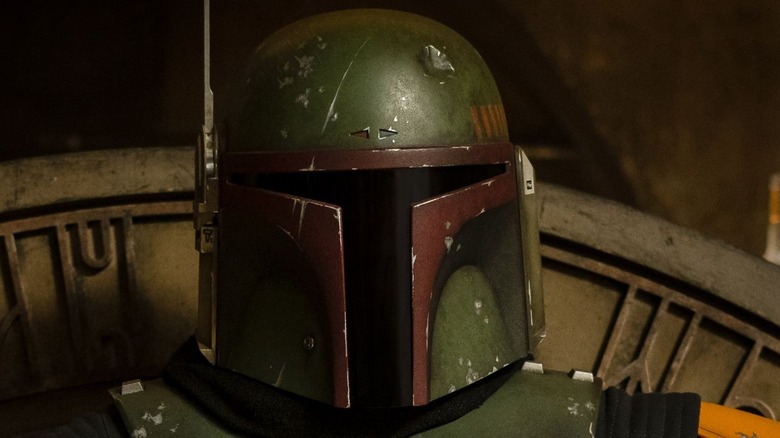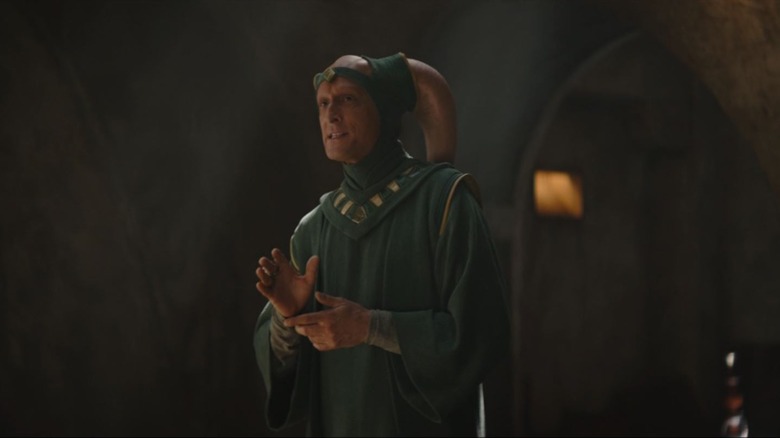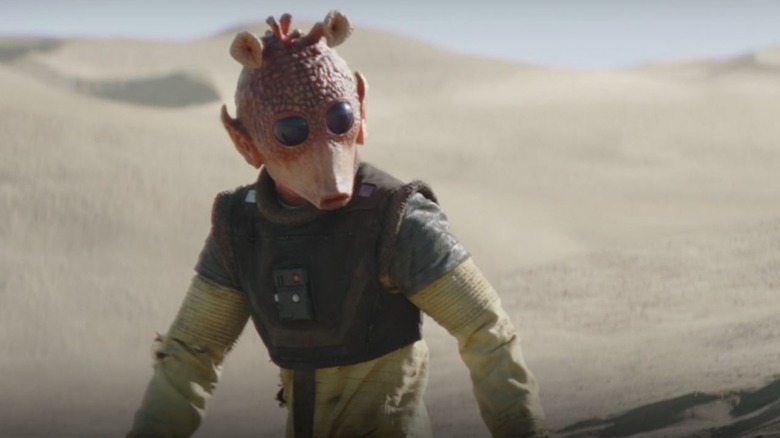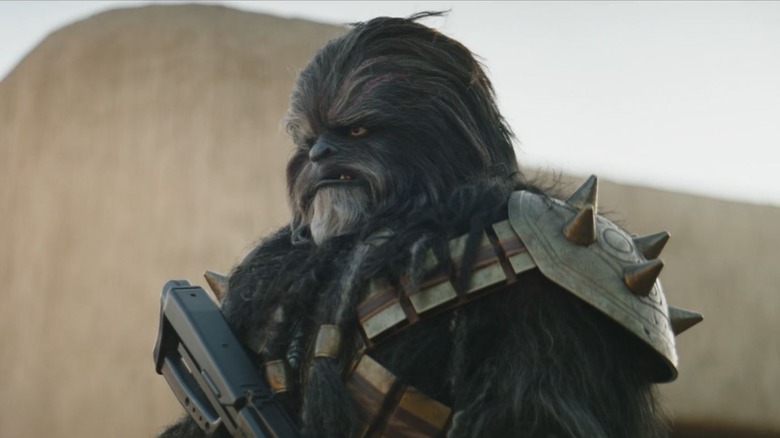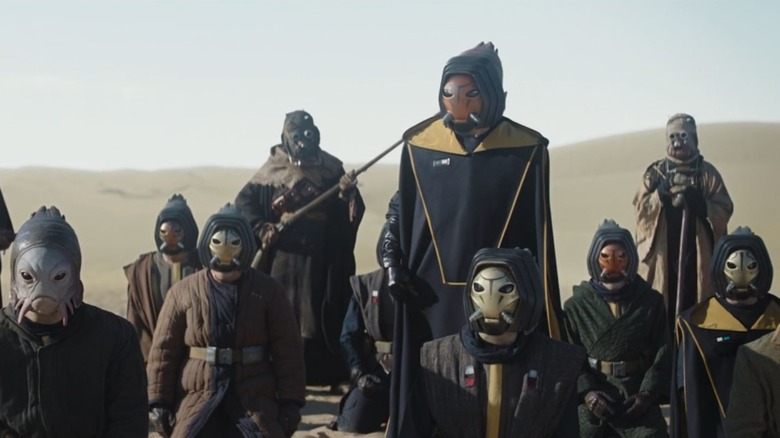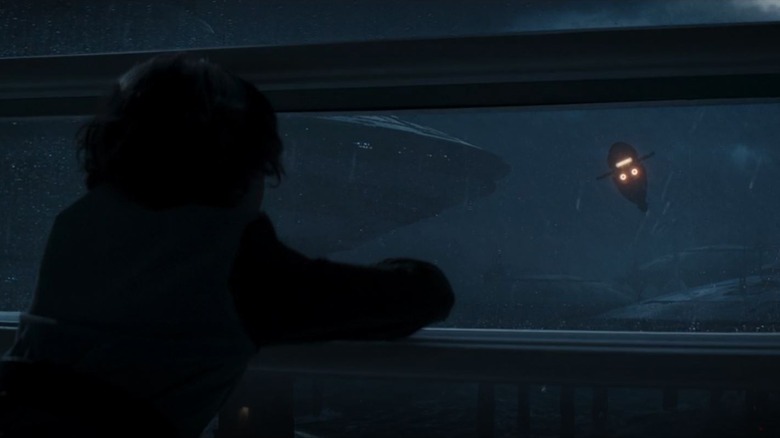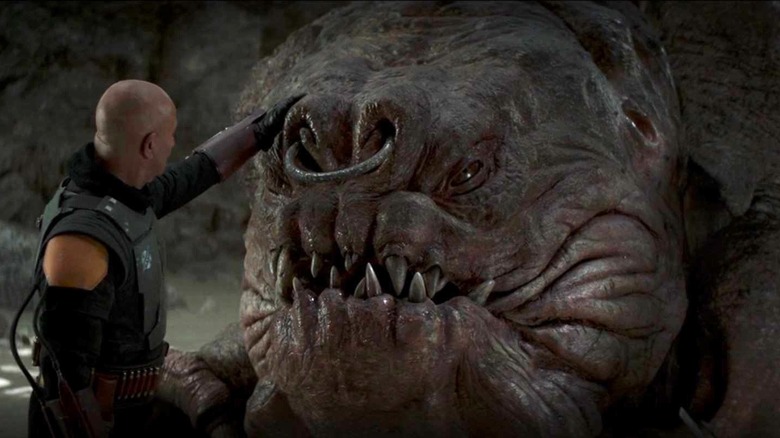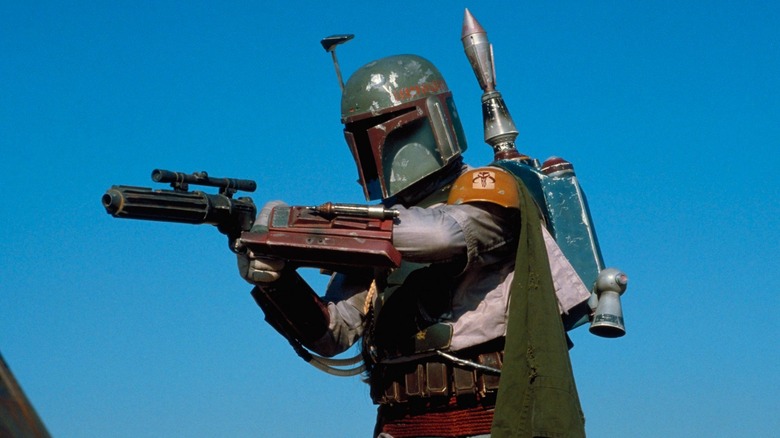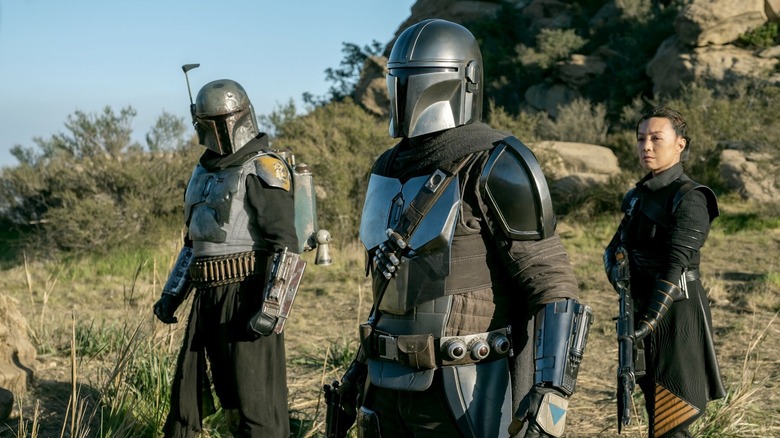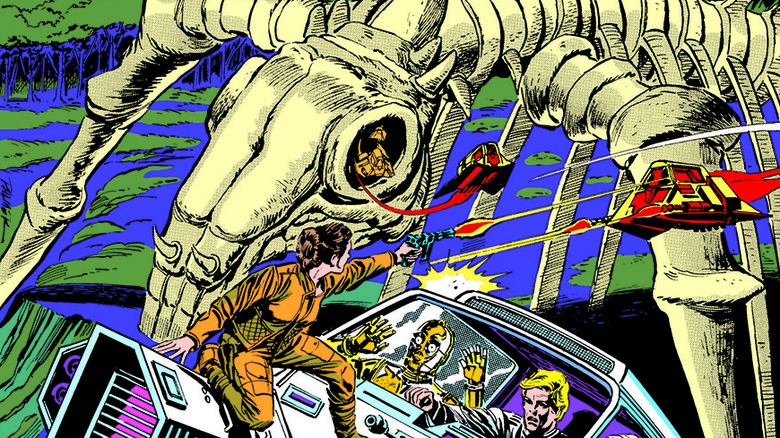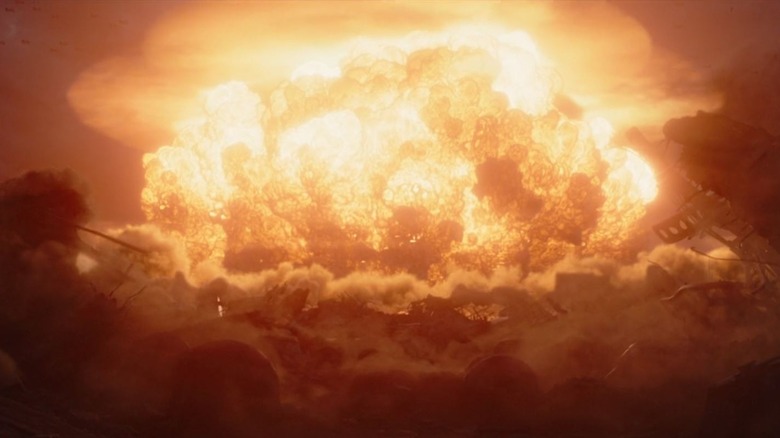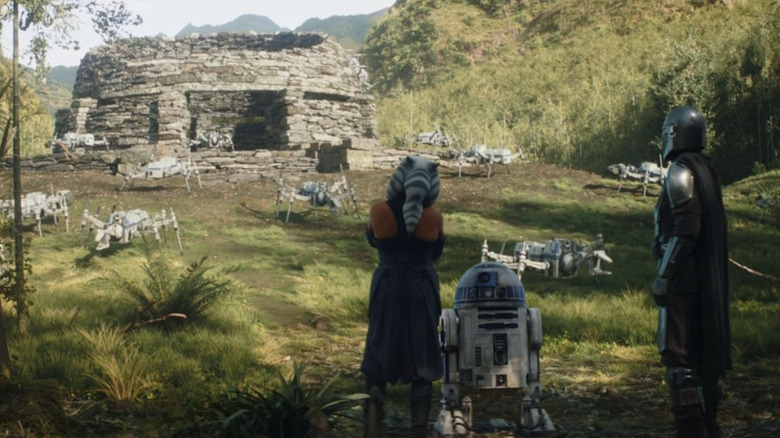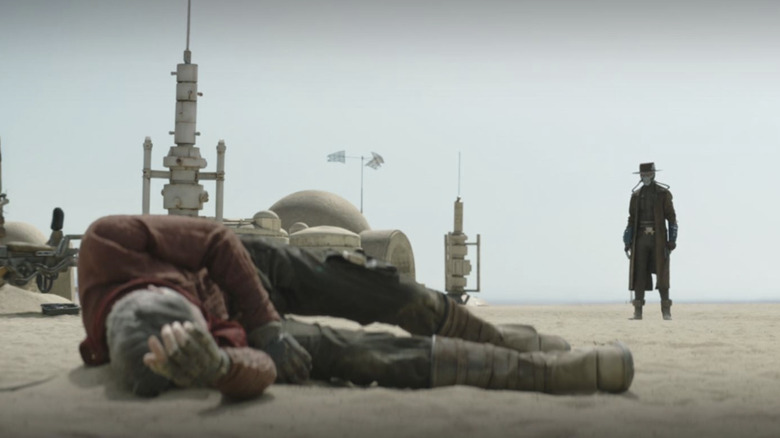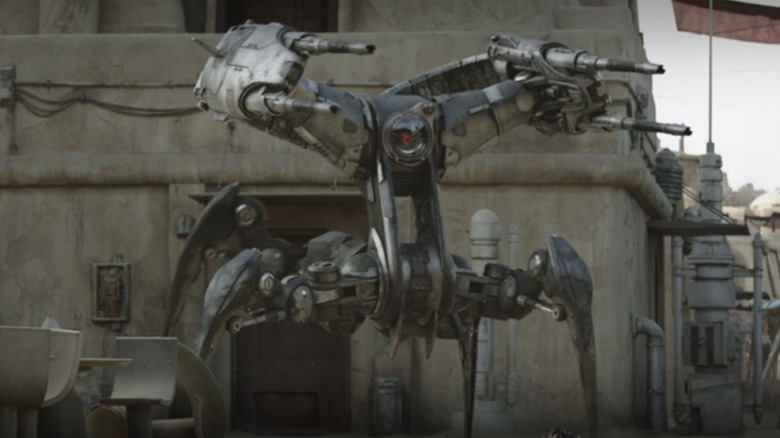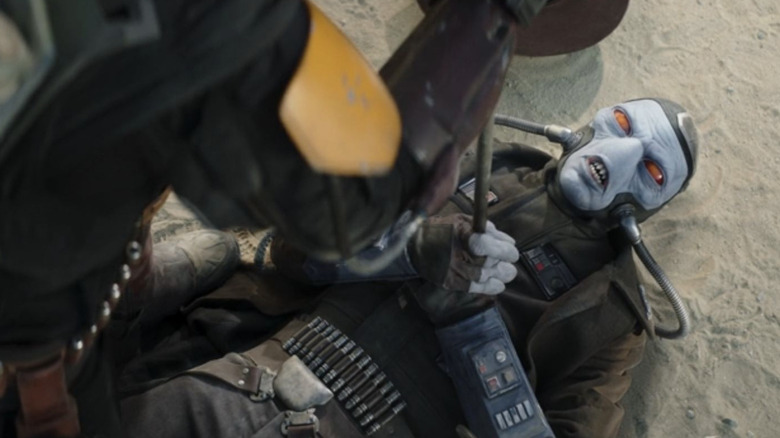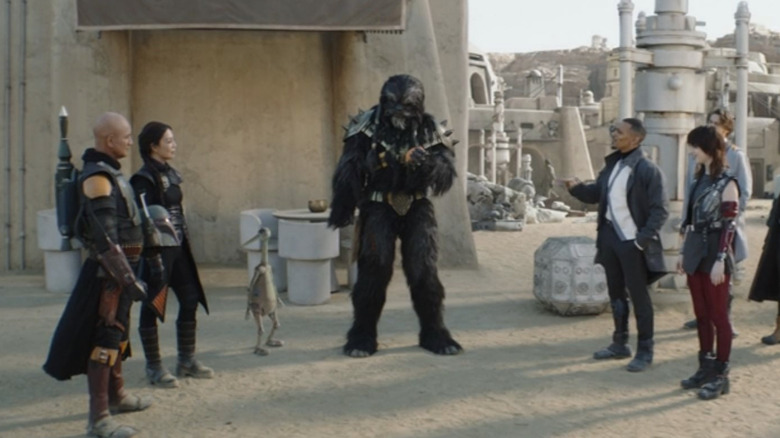Lines That Mean More Than You Realize In The Book Of Boba Fett
A standout "Star Wars" character since his late '70s/early '80s debut, the most feared bounty hunter in the galaxy far, far away finally received the spotlight fans had been clamoring for with the much-anticipated 2021 Disney+ series "The Book of Boba Fett." Spinning out of his appearances in Season 2 of "The Mandalorian," Fett begins the series ready to lay claim to whatever remains of Jabba the Hutt's former criminal empire.
With seven episodes revolving around the adored anti-villain, the series is packed to the brim with references and callbacks to the character's storied history throughout the franchise. The series tells much of its tale via flashbacks, explaining the bounty hunter's activities following his fall into the Sarlacc Pit in 1983's "Return of the Jedi." But this is also the story of a man who has been accused of a lot of things, but never of being verbose; with that in mind, here are the (often efficiently-utilized) lines of dialogue that speak volumes about the story of Boba Fett's past, present and perhaps even his future.
I would not be surprised if you receive another delegation in the near future
"The Book of Boba Fett" spends the opening third of its first episode, "Chapter 1: Stranger in a Strange Land," simultaneously detailing the aftermath of the bounty hunter's fall into the Sarlaac Pitt and his assumption of Bib Fortuna's throne. Fett returns to the show's "present day" when he's awoken from his regenerative bacta tank by Fennec Shand, so he can receive those who have come to pay their respects to the new crime lord.
The most prominent of these guests is the Twi'lek majordomo of Mok Shaiz, the mayor of the Tatooine city of Mos Espa. He has come in place of his boss and explains that the mayor refuses to pay tribute and demands that Fett pay him tribute instead.
The notorious bounty hunter allows the majordomo to leave unharmed despite the offense, and the Twi'lek offers one final warning as he departs: "I would not be surprised if you receive another delegation in the near future."
That future proved far closer than expected. Though it may have seemed like a set up for a future episode, the trained band of assassins that attack Boba and Fennec in broad daylight at the end of the first episode are a far less friendly "delegation" than the majordomo.
Sleemo!
Towards the end of those flashback sequences from "Stranger in a Strange Land," Fett finally has a chance to speak with the Tusken Raiders' other prisoner, a Rodian who alerted the guards when he first tried to escape. Determined to try again, the bounty hunter attempts to bargain with the alien, urging the quasi-Greedo to go along with an escape since the two are chained together. After being repeatedly ignored, Boba threatens his life, eliciting a response in Huttese that ends with the word "Sleemo."
Spoken by Jabba the Hutt and his species, "Huttese" is one of the Star Wars galaxy's most common "lingua francas." In linguistics, a lingua franca is any language used in order to facilitate trade and communication between people and groups who do not share native languages. In the "Star Wars" universe, wherever the Hutts rule, Huttese is used as the common, unifying language — and as a result, it's one of the most commonly heard languages in the underworld.
According to StarWars.com, the only clearly intelligible word spoken by this Rodian prisoner, "sleemo" roughly translates to "slime ball." It's an insult to be certain, but it's one that fans may recall hearing: Anakin Skywalker hurled it at Sebulba during the events of 1999's "The Phantom Menace."
These are not the death pits of Dur, and I am not a sleeping Trandoshan guard
Still working to consolidate his rule over Tatooine in "Chapter 2: The Tribes of Tatooine," Boba Fett discovers that two Hutts called "The Twins" have laid claim to the throne and empire of their late cousin, Jabba the Hutt. Obviously, this puts them at odds with the former bounty hunter, so the Twins bring an enforcer of their own: a massive Wookiee named Black Krrsantan.
Created for the comics by writer Jason Aaron and artist Mike Mayhew, Krrsantan is a bounty hunter introduced in 2015's "Star Wars" #15 and #20 as an opponent of Obi-Wan Kenobi during his time on Tatooine watching over Luke Skywalker from afar in between the events of "Revenge of the Sith" and "A New Hope." Kenobi had been disrupting Jabba's criminal activities, and he hired the Wookiee bounty hunter to find and kill him. Though he failed, he became an oft-recurring character in the franchise's comic books, especially within the "Doctor Aphra" series, and this episode marks his first appearance in live action.
Boba's comment that "These are not the death pits of Dur, and I am not a sleeping Trandoshan guard" during Krrsantan's introduction are direct references to the Wookiee's twisted backstory from 2017's "Doctor Aphra" Annual #1. Disgraced and cast out of Kashyyyk's Wookiee society, Krrsantan willingly joined a group of Trandoshan slavers so he could train and fight in their gladiator pits until he became a nigh-unstoppable killing machine.
If you are to pass, a toll is to be paid to them
The second half of "Chapter 2: The Tribes of Tatooine" is fully devoted to the series' extended flashback storyline. No longer a prisoner of the Tusken Raiders but their guest, Boba Fett works to help them eliminate a Pyke Syndicate train that's been moving through their territory and killing their people. After disabling the train in an intense, Western-influenced action sequence, Boba lets the Pyke survivors go after making sure they understand a new rule: "If you are to pass [through Tusken territory], a toll is to be paid to them."
The story explains how and why Fett was welcomed into the Tusken tribes as a trusted friend, potentially even as family or a full-blown member of the tribe, but it also calls back to the 2019 episode that originally introduced series regular Fennec Shand and first teased Boba's return: "The Mandalorian" Season 1, "Chapter 5: The Gunslinger." When Din Djarin and Toro Calican travel across the Dune Sea, Mando takes the time to stop and give the sand people the kid's brand-new macrobinoculars to pay for their safe passage, and a similar scene occurs when Mando returns to the desert planet in Season 2's premiere.
Since "The Mandalorian" takes place a few years after the "Book of Boba Fett" flashback sequences, it's entirely possible that Tusken collection of tribute from traveling outsiders started with Boba Fett's ultimatum to the Pyke Syndicate in this episode.
Tatooine was once completely covered with water
When a local water monger petitions Boba Fett to take care of a band of thieves who have been stealing his product, Boba comments that he used to live on a planet that was full of water, which sparks an interesting reply from the petitioner: "Tatooine was once completely covered with water." This isn't the first time this fact has been alluded to within the series, but it's also a concept that existed in the old Legends continuity.
The idea that Tatooine wasn't always a sandy wasteland was first introduced in the 2003 video game "Star Wars: Knights of the Old Republic." Players must visit Tatooine during the game, and if they manage to befriend the Sand People, they will offer to teach the player character about their history, explaining that over 25,000 years ago, the planet was "green with life" and highly advanced until their first ventures into space attracted the attention of the Rakatan species' "Infinite Empire."
A highly advanced civilization, the Rakatans enslaved the natives of Tatooine and mined the planet heavily until a plague weakened them enough for the natives to revolt. The brutal war didn't end until the Rakatans left and bombarded the world from orbit until its surface had turned to glass that eventually "ground to sand." The natives hid in caves until it was over, vowed to never take up technology again, and became the nomadic tribes that fans know and love today.
It is said that the Witches of Dathomir even rode them through the forest and fens
After Black Krrsantan fails to assassinate Boba Fett in "Chapter 3: Streets of Mos Espa," the Twin Hutts offer Boba a formal apology in the form of a Rancor calf like the one Jabba kept beneath his throne in "Return of the Jedi." Fett accepts the gift alongside their apology and tribute, and when he goes to visit the beast in its new home, the crime lord's new Rancor Keeper, played by Danny Trejo, teaches the former bounty hunter about his new pet.
He explains that they are emotionally complex creatures who bond to the first human they see and can be trained to perform incredible feats. In fact, he even tells Boba that "It is said that the Witches of Dathomir even rode them through the forest and fens."
This is a direct reference to the 1994 Dave Wolverton novel "The Courtship of Princess Leia" and one of the most iconic images from the old, pre-Disney "Legends" canon. In a story set after "Return of the Jedi," Han, Leia, and Luke spend the book navigating an Imperial Super-Star Destroyer and the Witches of Dathomir, whose Nightsisters rode Rancors into battle to great success against ATST Imperial walkers. Riding rancors became a popular trope and was seen in "Star Wars: Empire at War: Forces of Corruption," "Star Wars: The Force Unleashed," and "Star Wars: The High Republic #8."
I'm tired of our kind dying because of the idiocy of others
Ever since Boba Fett killed Bib Fortuna and took Jabba's throne, many fans have been wondering why the legendary bounty hunter suddenly wanted to become a crime lord. The fourth episode of "The Book of Boba Fett," titled "The Gathering Storm," finally answered that question.
The episode devoted the majority of its runtime to wrapping up the series' flashback storyline and finally catching up to where fans met Boba again in "The Mandalorian" Season 2, showing how he saved and befriended Fennec Shand, reclaimed his ship the Firespray, and attempted to convince the master assassin to join him in his plan to become the crime lord of Tatooine. Fennec is understandably skeptical of Fett's new motivations and of the reason for the sudden change, and his explanation is captured in a single quote that speaks to the character's entire history: "I'm tired of our kind dying because of the idiocy of others."
His father, Jango, was killed by Jedi because Count Dooku carelessly ordered the bounty hunter to engage an army of them in battle, a memory that has haunted Boba's dreams throughout the series. Similarly, Boba himself was consumed by the Sarlacc and nearly killed because Jabba was too proud to release Han Solo to the Rebellion. The Hutt foolishly believed he was safe from them, and because of that, Boba had to fight a Jedi and lost, just like his father.
Credits can buy muscle, if you know where to look
Faced with the prospect of an inevitable gang war against the Pyke Syndicate on Tatooine, Boba Fett tries and fails to convince the crime bosses that he supposedly rules to aid him in the fight. Though he, Fennec, Black Krrsantan, his young rancor, and his new crew of Gamorrean guards and swoop bikers are all excellent fighters, they are not an army, and Fett will need one if he is to repel his enemy's intergalactic criminal enterprise from the planet.
He needs muscle, but as Fennec Shand helpfully reminds him, he has credits, and "Credits can buy muscle, if you know where to look." As she finishes saying this, the theme from "The Mandalorian" plays, and the show lets audiences know exactly who she means: Din Djarin, aka "Mando."
Din has shown time and time again that he's willing to help his allies in a fight and is even more willing when there are credits involved, but the teaser is even more fitting considering the earlier events of the episode when fans saw Boba's perspective of Mando and Fennec Shand's fight from Season 1, "Chapter 5: The Gunslinger." The episode also set up the hunt for Fett's armor that would lead the pair to meet Din in the first place, and even replayed the original, post-credits teaser for this very show.
The songs of eons past foretold of the Mythosaur rising up to herald a new age of Mandalore. Sadly, it only exists in legends
Having teased Din Djarin's appearance at the end of the previous episode, "Chapter 5: Return of the Mandalorian" wastes no time bringing him back. Having now successfully delivered Grogu to the Jedi, Din tracks down and returns to his old Mandalorian convert from the show's beginning. Face to face with the Armorer and Paz Vizla once again, he shows them the Darksaber and learns of some of the legends and prophecies surrounding it.
One of the most interesting things that the Armorer mentions is this: "The songs of eons past foretold of the Mythosaur rising up to herald a new age of Mandalore. Sadly, it only exists in Legends." Fans will know this is a direct reference to the heart of Mandalorian history in both the real and fictional world.
When Boba Fett first appeared on screen in 1980, one of the most distinctive details on his armor was the horned skull emblem that was painted on his left shoulder. This emblem was first identified as the skull of a Mythosaur in Marvel Comics' "Star Wars" #69 in 1977. It's a symbol of the Mandalorian people that dates back to their earliest legends, in which driving the massive, deadly beasts to extinction was the first great and foundational feat of the warrior people.
Eventually, the Imperial interlopers destroyed all that we knew and loved in the Night of a Thousand Tears
The Armorer continues her history lesson as she reforges Din Djarin's beskar spear into something for Grogu. And once Din asks her about Bo-Katan Kryze, fans of "Star Wars: Rebels" finally receive many of the answers that they've been waiting for. Ever since Moff Gideon first used the Darksaber to escape the wreck of his TIE Fighter at the end of "The Mandalorian's" 1st season, the animated series' dedicated fans have been scratching their heads. See, the last time we saw the Darksaber, it was safely left in the hands of Bo-Katan by Sabine Wren, one of the show's starring characters. Bo-Katan was perfectly set up to become her people's next leader, so what went wrong in the years between?
Apparently, the fact that Bo-Katan did not win the sword in combat weakened her ability to lead the Mandalorian people and, to some extent, led to the dark day in history when the Armorer says, "Eventually, the Imperial interlopers destroyed all that we knew and loved in the Night of a Thousand Tears." Based on the flashback footage, it looks like the dome the TIE Bombers destroyed during the Great Purge may have been Sundari, the domed capital city of Mandalore that viewers visit multiple times throughout both "The Clone Wars" and "Rebels."
It's nothing now, but will someday be a great school
The Mandalorian Din Djarin has been recruited to fight in Boba Fett's war against the Pike Syndicate — but first, he has to try to visit his adopted son, Grogu, in "Chapter 6: From the Desert Comes a Stranger." He follows R2-D2's signal to an unnamed planet filled with lush greenery and gorgeous vistas. Din asks to see the kid, and the droid leads him to a clearing where a number of large, ant-like droids are building a familiar-looking stone temple. Eventually, Ahsoka meets Din at the construction site and tells him that the stone hut is "nothing now, but will someday be a great school."
She's at least half-right, because this appears to be the same temple that moviegoers saw in a series of flashbacks from "Star Wars: Episode VIII: The Last Jedi." In those scenes, audiences watched as Luke attempted to confront Ben Solo and the rising darkness sensed within him. Instead of talking to the boy, however, he nearly chose to kill Ben in his sleep, prompting the young prodigy to lash out in fear and anger, join the Knights of Ren, and ultimately destroy the very structure being built here.
You should've never given up your armor
Hitting the same beats as his surprise appearance in "Star Wars: The Bad Batch," Season 1, Episode 8, "Reunion," the popular bounty hunter Cad Bane made his unexpected live action debut on Disney+ in "Chapter 6: From the Desert Comes a Stranger" with a duel that leaves a popular character beaten, but likely not killed. He's been hired by the Pyke Syndicate in their war with Boba Fett, and his inclusion in the show brings with it a wealth of history that's summed up quite well with one line: "You should've never given up your armor."
Fans have seen Bane in several classic gunfighter duels by now (via other "Star Wars" media), and the only duel he ever lost was to Boba Fett in a cancelled episode of "Star Wars: The Clone Wars." The gunfight nearly killed Bane and gave Boba Fett the distinctive dent in his helmet that can still be seen to this day in "The Book of Boba Fett." The only reason Boba survived that episode was because of the very same armor that Cobb Vanth had recently given away. It's hard to say whether or not it would have saved the marshal here, but it certainly would have helped.
We've got a Scorpenek droid chasing us!
In "The Book of Boba Fett," "Chapter 7: In the Name of Honor," war finally breaks out between Boba Fett and the Pyke Syndicate, and the alien gangsters aren't messing around. After the Syndicate's first plan to simply overwhelm Fett and his soldiers fails due to the timely arrival of the Freetown fighters, the criminals unleash two monstrous, hulking droids that looked like giant-size versions of the iconic Droideka destroyers.
These behemoths walk on four legs, have two "arms" fitted with turbo lasers and sharp claws, and are equipped with near-impenetrable shields. Boba and his forces have no defense against the machines and are quickly re-routed before Peli Moto is able to identify them: "We've got a Scorpenek droid chasing us!."
Though this is the droid's first appearance onscreen in live-action, they've actually been around since 2006's "The New Essential Guide to Droids" first identified them. Before this episode, mentions of the droid could only be found within various guide books and encyclopedias, and their inclusion in "The Art of Star Wars Episode II: Attack of the Clones" suggests they were initially dreamed up during the conceptual phase of that film's development.
I'm not a little boy any longer.
Towards the end of "Chapter 7: In the Name of Honor," Cad Bane and Boba Fett are finally going head-to-head in the epic rematch of a duel that fans never actually saw. As mentioned above, Bane's surprise reveal in the previous episode drew on the history of a cancelled story from "Star Wars: The Clone Wars" that ended with their first duel, but the pair's chat throughout their final duel references the story that led to that original gunfight.
Multiple episodes throughout that animated series featured either Cad Bane or a young Boba Fett but never both because of the cancellation, keeping them from finishing their respective character arcs in the show. Boba spent the series trying to live up to his dad's reputation, while Cad wanted to train the boy to achieve that goal because he never had the chance to defeat Jango and prove he was the deadliest bounty hunter in the galaxy. Cad and Boba travel and work together across several missions, and once Boba is ready, they finally duel.
When Fett tells Bane that he's "not a little boy any longer" in "The Book of Boba Fett," he is referencing these episodes, as is Cad when he tells Boba to "Consider this my final lesson." Between this and "The Bad Batch," this cancelled story arc has become increasingly important to the franchise's universe, so hopefully fans will someday get to see it finally come to life.
So the Wookie gets a melon, and we don't?
After defeating the Pyke Syndicate and driving them off of Tatooine for good, Boba Fett and Fennec Shand walk through the grateful streets of their new city, Mos Espa. The citizens bow to them and even give Boba a "Meiloorun" fruit as thanks. Fett accepts the gift but isn't particularly interested, so he gives it to Black Krrsantan instead who immediately begins to eat it.
This prompts one of Boba's biker underlings to quip: "So the Wookie gets a melon, and we don't?" Though it's a teasing, rhetorical question, Krrsantan's roars make it clear that the answer is a definitive "yes," firmly cementing this as a clever inversion of the finale to the original 1977 "Star Wars" film.
After destroying the Death Star and saving the Rebel Alliance in what we now know as "A New Hope," Princess Leia presented the Rebel heroes with gold medals in the movie's final scene — but Chewbacca, Han Solo's Wookie co-pilot, conspicuously did not receive one.
Fans have made fun of the moment for years, prompting J. J. Abrams to finally give Chewbacca a medal at the end of "Star Wars: Episode IX: Rise of Skywalker" in reference to the meme. This line references the medal fiasco, as well as flipping it on its head; instead of the Wookie being the only one who doesn't get a reward for saving the day, he is the only one who does.
